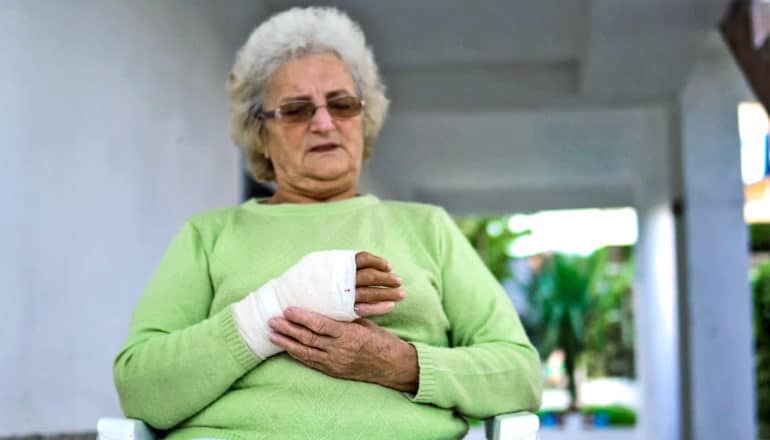
A protein more prevalent in older people interferes with bone healing, report researchers.
Broken bones are a bigger deal the older you are: even after they’ve healed, the bones of older people are weaker and more likely to re-fracture. And since more than 6 million Americans break a bone each year, figuring out how to help people heal better would make a big difference, researchers say.
“When we decreased the protein level, aging was reversed,” says Gurpreet Baht, an assistant professor in the Duke University orthopaedic surgery department and senior author of the paper in JCI Insights. “Not only was there more bone and healing happened faster, but it was also structurally more sound.”
Baht’s team confirmed that older people have more Apolipoprotein E, (ApoE) than younger people. Researchers have also implicated ApoE in Alzheimer’s and heart disease.
The researchers discovered that that 75-85 year olds have twice as much ApoE in their bloodstreams as 35-45 year olds, then found the same was true for 24-month-old mice versus 4-month-old mice, which approximate the same human age ranges.
Bone-building cells
Next, they wanted to figure out if and how ApoE affects the multi-step process of bone healing. When you break a bone, your body sends signals through the bloodstream to recruit cells to fix it. Some of those recruits, specifically skeletal stem cells, build up cartilage as a temporary scaffolding to hold the fracture together.
In the next step, more recruited cells mature into osteoblasts, bone-building cells, which lay strong, dense bone cells on top of the cartilage scaffolding. Finally, a different kind of cell eats up the cartilage scaffolds and osteoblasts fill those holes with bone.
“Over time, this cartilage will continue to be resorbed and osteoblasts will continue to deposit new bone,” Baht explains. “After a few months of your arm or leg healing, there will be almost no cartilage anymore. And if you were to look at it five years out, there’d be no sign of an injury anymore.”
That’s if the bone healing process works perfectly. But the researchers found that if they added ApoE to a petri dish with skeletal stem cells, fewer cells developed into osteoblasts and the osteoblasts were worse at building bones.
“We wanted to see if the cell population was more or less capable of becoming osteoblasts,” Baht says. “[Normally,] you put these cells down in a petri dish for about a month and the dish becomes so hard that you can’t even scratch the surface because they’ve made two-dimensional bone there. ApoE-treated cells are still able to do this, they just don’t do it as much or as well.”
What about removing ApoE?
Next, the researchers created an intervention by injecting a virus which keeps mice from making ApoE protein. Circulating ApoE levels dropped 75% and the healed bones contained one and a half-times more strong, hard bone tissue than bones of untreated mice.
Past researchers linked ApoE to Alzheimer’s disease and atherosclerosis, a disease in which fatty plaques narrow the arteries. Too little ApoE, and fat builds up and can cause cardiovascular issues. The liver virus which turned off ApoE production in mice acts permanently, so Baht’s next step is to investigate other interventions.
“You have to be careful,” Baht says. “If a patient were to permanently decrease circulating ApoE levels, and then have a fatty meal, that fat might not get processed properly and could deposit in blood vessels. In our future studies, we’re going to try to temporarily lower ApoE.”
“As a treatment to improve bone healing, the patient could take a pill or an injection to lower ApoE for a short time rather than permanently, and there would be dietary restrictions during treatment. That would be probably a much safer model,” Baht says.
The Duke Center for the Study of Aging and Human Development and Claude D. Pepper Older Americans Independence Center, the American Diabetes Association, and a Borden Scholar Award funded the work.
Source: Yen Duong for Duke University
The post This protein slows the healing of broken bones appeared first on Futurity.
from Futurity https://ift.tt/2lopCeA
No comments:
Post a Comment